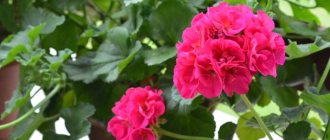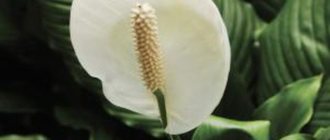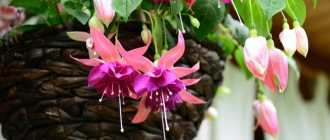Indoor flowers with lemon scent: names, descriptions and photos
Geranium (Pelargonium graveolens)
A plant with small pink or purple flowers.
The leaves are carved, reminiscent of grapes, covered with tiny fibers on both sides. The plant can reach a height of over one meter. Geranium has antiseptic properties, kills bacteria in the air and absorbs odors, which is why this plant has found a place in the kitchen.
It has a calming effect and is widely used in aromatherapy.
We invite you to watch a video about fragrant geranium:
Murraya
An evergreen tree reaching a height of 1.5 meters at home. The leaves are dark green in color with a distinct citrus flavor and smell. A distinctive feature of the plant is the simultaneous appearance of delicate white flowers of small size and red elongated berries, similar in appearance to rose hips.
- Phytoncides contained in the leaves purify polluted air, help treat headaches and cardiovascular diseases: hypertension, angina pectoris and more.
- Microelements improve mood and stimulate mental activity.
- Murray berries, sweetish in taste, improve tone and are used to prevent the body from fading.
We invite you to watch a video about the muraya plant:
Plectranthus aromaticum or spur flower
A perennial herbaceous plant with fleshy, rounded leaves covered with hairs. White, lilac and violet bell-shaped flowers of the spur flower are collected in multi-flowered inflorescences. At home it reaches 80 centimeters in height.
If you break the plant, you can smell a strong mint-lemon aroma.
Medicinal infusions from aromatic plectranthus:
- have anti-inflammatory and analgesic effects;
- have a moderate laxative effect;
- help with heartburn and gastritis;
- improve appetite;
- relieve rheumatism.
Fragrant indoor plants
The smell of a home consists of a large number of aromas. Among its components there are various types of flowers, the delicate scent of which is a worthy alternative to air fresheners and interior perfumes. When choosing scented indoor plants, it is important not to go overboard. Heavy odors or an excess of spices are not the best for creating home comfort. It is also necessary to take into account that among flowers with a charming aroma there are conditionally poisonous ones, constant proximity to which in a confined space is undesirable. The choice will be different for different rooms inside the house.
Spicy and medicinal herbs whose leaves smell like citrus
Melissa officinalis
Grown in Europe and North America. A perennial herbaceous plant with oval leaves with toothed ends and a relief structure. The inflorescence consists of several small corollas with white or bluish petals.
- Preparations based on lemon balm have a pronounced sedative effect. They help treat insomnia, relieve spasms, and have choleretic, diuretic and healing effects.
- Tea lowers blood pressure and soothes inflamed mucous membranes of the gastrointestinal tract.
Consuming lemon balm is beneficial for women's health:
- normalizes the menstrual cycle;
- relieves inflammation of the appendages;
- during pregnancy it alleviates toxicosis.
We invite you to watch a video about lemon balm:
Cat mint
Distributed in central Russia, Southern and Central Europe, the North Caucasus, the Far East and the USA.
The plant is about one meter high and has a woody stem with carved heart-shaped leaves; the inflorescence consists of small petals of a white or lilac hue.
Cat mint:
- treats insomnia;
- calms the nerves;
- facilitates the removal of mucus during bronchitis;
- relieves spasms of the brain and intestines;
- causes appetite.
The plant is used in the veterinary field, to prevent the appearance of worms in animals, and also as a sedative for cats.
We invite you to watch a video about catnip:
Moldavian snakehead
It grows in most of Eurasia and North America in temperate climates. A herbaceous plant with small elongated leaves with serrated edges. Purple flowers form a racemose inflorescence. The snakehead grows up to 80 centimeters.
Plant:
- Can help with neuralgia, headaches and toothaches.
- Improves digestion.
- Increases immunity.
- Has a choleretic effect.
- has an antiseptic effect.
- Heals wounds and relieves inflammation.
We invite you to watch a video about the Moldavian snakehead:
Lemon Basil (Ocimum x citriodorum)
Originated from Central and South Asia and spread throughout the world. Plant up to 50 centimeters high. A strong branched stem with many small, rough, oblong leaves. The flowers are produced at the top of the branch and are white or pale pink in color.
Used for gastrointestinal and bladder diseases, flatulence and bloating.
Lemon verbena (Aloysia citriodora, Aloysia triphylla)
It grows on almost all continents, but South America is considered its homeland. A lush plant with narrow arched leaves. It blooms in small inflorescences of a light purple hue (reminiscent of a lilac branch). Has a pronounced lemon smell.
Verbena:
- treats diseases of the digestive tract;
- calms the nervous system;
- tones the body;
- improves mood.
It is a real salvation for skin rashes, evens out complexion and rejuvenates.
We invite you to watch a video about lemon verbena:
Lemon thyme (Thymus x citriodorus)
Grown in the temperate climate of the northern hemisphere. Perennial plant, up to 30 centimeters high.
The leaves are round and small, dark green in the middle and with a pale green tint at the edges. The flowers are lilac.
- In medicine, the plant has proven effective in treating respiratory diseases.
- Inhibits the development of pathogenic microflora.
- Normalizes the production of gastric juice.
- Strengthens heart health.
- Helps improve sleep.
We invite you to watch a video about lemon thyme:
Lemon savory
Distributed on all continents, native to the Mediterranean. A perennial with creeping shoots and narrow elongated bright green leaves. The pink or purple flowers emit a concentrated lemon scent.
Used as an antibacterial and anthelmintic agent. Helps cope:
- with headache;
- tachycardia;
- cystitis;
- with gastrointestinal diseases.
Lemongrass
Grows in India, Thailand, China, Africa and America. An evergreen perennial plant that looks like a tuft of grass. In tropical climates it can reach 1.8 meters in height.
- Lemongrass normalizes the functioning of the digestive system.
- Effective for headaches, skin rashes, rheumatism.
- Increases the tone and performance of the body, helps fight colds.
- Reduces oily hair, removes toxins, burns cellulite.
Lemmon's marigolds
Lemon marigold is a perennial herbaceous plant up to 120 centimeters tall with narrow long leaves 5-15 centimeters long. The small yellow flowers exude an amazing aroma, a mixture of citrus, mint and a subtle hint of camphor. The homeland of the plant is called the USA and Mexico.
Marigold oil has antimicrobial, antifungal, antispasmodic and sedative properties.
Shrubs
Wormwood "God's Tree" (Artemisia abrotanum)
Widely distributed throughout Russia, the European part, Siberia and the North Caucasus. Perennial subshrub, up to 150 centimeters high. The leaves are bluish-green, pressed underneath, covered with gray down. Small yellow flowers in small, drooping baskets are collected at the top of the stem and form a spreading paniculate inflorescence.
Decoctions of wormwood leaves are used for:
- colds, flu, sore throat;
- rheumatism;
- toothache, gum inflammation;
- menstrual irregularities;
- as a choleretic agent;
- to strengthen hair.
We invite you to watch a video about wormwood:
Callistemon lemon
Mostly distributed in Australia, in Russia it is grown at home. In the wild, the bush reaches 3 meters in height, has green, linear-lanceolate leaves, sharp at the top, up to 9 cm long and 1 cm wide. Flowers of unusual shape, reminiscent of “kitchen brushes” in red or pink. The leaves exude a bright lemon aroma.
Callistemon lemon has antibacterial properties and can disinfect indoor air.
We invite you to watch a video about Callistemon lemon:
Most plants, herbs and flowers that smell of lemon not only perfectly imitate the citrus smell, but are also a source of valuable natural trace elements. Their correct use will give a person beauty and health for a long time.
Description of the geranium plant
Pelargonium is a species of the Geramiaceae family. Fragrant pelargonium is often called scented geranium. The confusion in names occurs because the plants have very similar foliage and are all identified as the same family. Geranium is a plant called Herb Robert, as well as cranes-bill because of the shape of the fruit's seed pod, or storks-bill for its resemblance to a bird's beak.
Lat. Geranium
Pelargonium leaves have a very distinctive appearance. They have beautiful, sometimes deep slits, and their curved shape sometimes resembles a ruffled frill. The color spectrum of their foliage is from light green to dark green, and the leaves of some species have cream, red and even purple colors. The plant reaches a height of 30 to 80 cm.
The geranium family of the genus Pelargonium has more than 200 species. Among them, the five most common types can be identified:
- decorative deciduous;
- ivy or balcony;
- fragrant;
- English, they are noble;
- zonal (standing).
You can also pay attention to the sixth type - these are succulent pelargoniums; they have fleshier stems and an original appearance, for which they are often used in ikebana and bonsai compositions.
Lemon geranium leaves are oblong, lush due to their dissection, and have a bright green color. With proper care, the plant grows up to half a meter in height, sometimes even higher. But it is believed that the decorative function is better performed by young geraniums while the plant trunks have not yet become lignified. This plant looks very fresh and tender
Lemon geranium got its name because of the aroma it exudes with every slightest touch. The fragrance of this plant is reminiscent of the fresh and sparkling smell of lemon.
Common diseases and pests
Lemon geranium is quite resistant to various kinds of diseases . Most often, troubles happen due to improper care. As a result, the plant:
- leaves turn yellow;
- the root system rots;
- yellow or white spots appear;
- the green mass fades;
- no flowering;
- The red color appears at the ends of the foliage.
Such symptoms can be easily eliminated by optimizing the maintenance parameters and adjusting the principles of care.
Sometimes gray mold disease occurs in lemon geraniums . You can get rid of it by cutting off damaged shoots and treating the flower with antifungal drugs. These drugs are also used before wintering plants for preventive purposes.
If geranium is affected by infectious diseases, which is rare, then it is best to use fungicides for treatment.
Due to the intense smell and thick leaves, the flower of this variety is practically not affected by harmful insects. Only white flies and sometimes aphids can be a nuisance, but they can be easily eliminated with soapy water or insecticides.
Necessary care for lemon geraniums
Geranium breeders often face the problem of rare flowering and “correct” this deficiency with generous fertilization or bright daytime sun. This is not worth doing. The main reason for the lack of flowering of lemon geranium is excessive fertilization and heat. Fertilizers can provoke the growth of luxurious green mass, but not flowering. The situation can be corrected by two days of abundant watering; this will help wash away the fertilizers from the root system, and after that you should immediately return to the normal watering regime without fertilizers.
Fans of geranium flowers should remember that only zonal geraniums prefer very bright light and if there is not enough light, they stop blooming.
During the cold season, they even need additional lighting to stimulate their flowering. Other types of plants should be placed in places of partial shading, especially during the daytime and summer.
Lemon geranium will tell you about insufficient lighting with its increased growth and light-colored leaves, by this it expresses the need for sunlight at least 6 hours a day.
Adult geranium bush
With increased growth, you need to pinch the shoots and the plant will grow wider.
In winter, geranium should be removed from a cold place; its temperature should be +8-12 degrees.
Caring for lemon geranium is not difficult, you just need to follow the basic rules for maintaining the plant. Basically, you need to properly monitor the lighting, hide the flower from direct sunlight, water it not often, but regularly and not very abundantly, spraying is allowed only in extreme heat.
Home care
Lemon geranium grows and develops well at home. In order for the plant to be comfortable, some recommendations should be followed. The optimal air temperature is about 20 degrees. The plant loves moisture and needs regular watering; in summer the procedure should be carried out daily, but in winter it should be reduced to a couple of times a week. The main thing is to control the absence of stagnation of water and excess liquid. You should not spray geraniums; this can lead to the appearance of light yellow spots, which significantly spoil the appearance.
The plant needs fresh air, so if possible it is recommended to ventilate the room, however, the possibility of drafts must be excluded. Geraniums require annual replanting; it is best to do it at the very beginning of spring. Pruning is also done in the spring, but pinching is done in the fall.
It should be borne in mind that during the flowering period the lemon smell will become much weaker. To prevent this, you can carefully remove the buds from the bush.
It is best to use special products for feeding. “Mr. Color” and “Gilea” are perfect. Before using them, you must carefully read the instructions. The flower needs to be fertilized in spring and autumn. Cold water should not be used for irrigation. It must be clean, filtered or settled.
Recommended water temperature is +30 degrees.
What herbs smell like lemon?
Among herbs, there are many varieties with a citrus aroma. Fragrant plants will create a cheerful atmosphere in your favorite garden and open up new opportunities for culinary exploits.
The lemon aroma has a refreshing effect, relaxes and gives a feeling of carefreeness - just what the doctor ordered for complete leisure!
You will fully appreciate this healing effect by filling a corner of the garden bed or flower garden with representatives of the flora with the “lemon spirit.” There are quite a few such “fresheners” among plants, and they look very decorative.
Like most herbs, our heroes prefer a sunny place and permeable soil with a slightly acidic or neutral reaction. In a pot, it is better to grow them in a special substrate for herbs or, as an option, in soil for seedlings.
You can also prepare your own mixture of sifted garden soil, coarse sand and mature compost, taken in equal parts.
Aloysia thryphylla (Aloysia thryphylla) captivates with its purest lemon aroma. Its narrow leaves contain so many essential oils that the slightest touch is enough to fill the air with a strong scent. In intensity it surpasses the aroma of other “lemon” herbs.
In Mediterranean herbs, such as lemon thyme and the lemon variety of mountain savory, the citrus note is not the main one, but harmoniously complements the bright tart or sweet aroma. Accordingly, such greenery will pamper you with a whole bouquet of smells.
By the way, it’s impossible to appreciate the merits of “citrus pets” without showing tenderness to them - not only lemon verbena, but also pelargonium and thyme release essential oils only if you rub the leaves between your fingers or even just touch them.
In the kitchen, all of the above plants can be used in dishes that welcome a citrus note without the acid of the prototype, for example in sauces, soups, salads, fish dishes and desserts.
Safe fragrant indoor plants for comfort and tranquility in the home
Filling your home with exotic aromas is not a problem today. But if you are not tempted to surround yourself with “sea freshness,” fragrant indoor plants will come to the rescue. The right selection of green friends will give your home an exquisite fragrance and a good mood for you. You just need to follow a few rules when arranging colors in rooms. Otherwise, the effect may be the opposite. Find out what you can grow in your bedroom and how to best green your kitchen and living room.
Houseplants for scent in the bedroom
Probably the most recognizable and widespread fragrant indoor flower is geranium . The famous rolls have been decorating the window sills of city apartments for many years. This plant has received such widespread recognition for a reason: its fragrant smell has healing properties.
According to recent studies, the aroma of geranium can easily cope with stress, give a boost of positive emotions and even help improve vision.
A large selection of modern varieties allows you to choose the scent to suit your taste. Lemon, lemon balm, rose, and even chocolate and Coca-Cola - this is not a complete list of fragrant compositions of affordable and easy-to-care geranium.
To get rid of insomnia, place plectranthus . This unpretentious plant is often called home or indoor mint. The fleshy leaves of plectranthus produce the same pleasant, soothing aroma as its close relative, peppermint. And this is not the only similarity.
Homemade mint can be added to tea or used as a seasoning for various dishes. Even beginners in floriculture can care for plectranthus. Good watering and a bright room are all this indoor plant needs with a pleasant aroma.
If experience allows, you can purchase an equally useful indoor plant - lavender . This valuable essential oil shrub is famous for its pleasant aroma, but requires some skills for cultivation and care.
Lavender feels great on the south side in a well-ventilated area, but without drafts. The soil for it is selected to be sandy with a small addition of lime. You should not be overzealous with watering; the soil should dry out between them.
Another fragrant helper in the bedroom can be any citrus tree . At home, you can grow indoor lemon, orange, tangerine, calamondin and even grapefruit. With proper care, these plants will give not only a pleasant sweet aroma, but also home-grown fruit.
There are no obvious rules for arranging flowers around the apartment, however, many fragrant indoor plants should not be kept in the bedroom. It’s better to give them a place in the living room or another room.
Fragrant plants for common rooms
Gardenia is a beautiful, but capricious flower. Its bright green, glossy leaves are eye-catching, and its flowers are fragrant with a rich floral scent. This plant belongs in a well-lit living room. Just remember to carefully protect the beautiful gardenia from any drafts.
Exotic guests - orchids . It is difficult to find fragrant species of this flower on sale. However, if you are lucky, you will be able to enjoy extraordinary aromas.
Orchids imitate the smell of flowers, just as a nightingale imitates other birds. Therefore, among these imitators of the flower world there are many who smell like roses, hyacinth, lily of the valley or lilies. There are specimens with the smell of candy, coffee or chocolate. The signature scent of the orchid is considered to be vanilla.
A miniature rose will decorate any room with its presence . The bright and at the same time delicate aroma of the plant has a positive effect on well-being and is considered a powerful aphrodisiac.
Rose is the recognized queen of flowers. And like any queen, even an indoor one, she is slightly capricious. There is no place for it near a radiator or a south window, as overheating will be simply destructive.
Indoor fragrant plants in the kitchen
A garden of herbs on the windowsill will give the kitchen a pleasant aroma of something delicious. The tantalizing smell of spices will increase your appetite and have a beneficial effect on digestion. When choosing plants for your fragrant garden, trust your taste. Peppermint (savory), catnip or rosemary will look great in pots.
Cuban oregano, also known as broadleaf thyme, is also suitable for keeping at home. The plant does not require complex care and grows easily in sunny places where there are no drafts. Watering should be kept moderate, as excess water will be harmful.
Noble laurel is just as unpretentious . The fragrant leaves of this shrub are familiar to all cooks. So why not make it a useful addition to your kitchen decor? In addition, laurel has healing properties. Its smell is useful for inflammation of the respiratory tract and intestinal spasms.
Citrus indoor plants with fragrant leaves and fruits, which were already mentioned earlier, are perfect for the kitchen. The smell of lemon will lift your spirits and help drive away fatigue and anxiety. The aroma of orange or tangerine will increase concentration, improve memory, and give a charge of vigor and optimism.
But no matter what part of the house the improvised fragrant garden is located in, the main thing is to avoid excessive concentration of the smell. To do this, you need to make sure that several plants do not bloom at the same time. Or place them in spacious and well-ventilated areas.
Source: https://zhenskie-uvlecheniya.ru/bezopasnye-aromatnye-komnatnye-rasteniya-dlya-uyuta-i-spokojstviya-v-dome.html
Propagation by cuttings
Spicy herbs whose shoots become woody at the base, such as savory, mint, lemon balm and thyme, can be easily propagated by apical cuttings.
To do this, you will need shoots about 10 cm long, on which buds have not yet appeared.
The cut should be made directly under the leaf node. Carefully remove the lower leaves, being careful not to damage the area at the base (leaf node).
For species with large leaves, such as lemon verbena (pictured), the remaining leaves should be cut in half to reduce evaporation. Fill the pots with seedling substrate or a mixture of sand and compost in equal parts.
Insert the apical shoots into the substrate to a depth of approx. 5 cm, compact the soil around the cuttings, water and then make sure that the substrate does not dry out. When the cuttings take root and produce young shoots, they can be planted in separate pots.
Below are other entries on the topic “Do-it-yourself cottage and garden”
- August is the time to stock up on spicy, aromatic herbs: It’s time to stock up on herbs with its unsurpassed...
- Flowerbed with herbs and aromatic plants - planting scheme: Plants and planting scheme for...
- We tame wild herbs and use them for cooking: What wild herbs can be used...
- Caring for a garden of cereal herbs - planting and pruning (photo): Garden of cereal herbs -...
- Italian herbs - growing on the balcony and windowsill: Composition of Italian herbs - growing...
- Herbs against autumn colds - herbalist advice: What herbs to brew for coldsAutumn...
- Copper-gold plants for garden design - photo, name and description: Autumn garden design - selecting...
Subscribe to updates in our groups.











